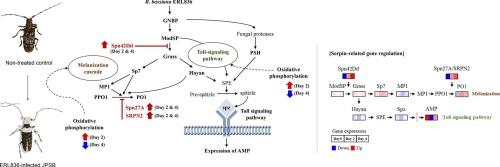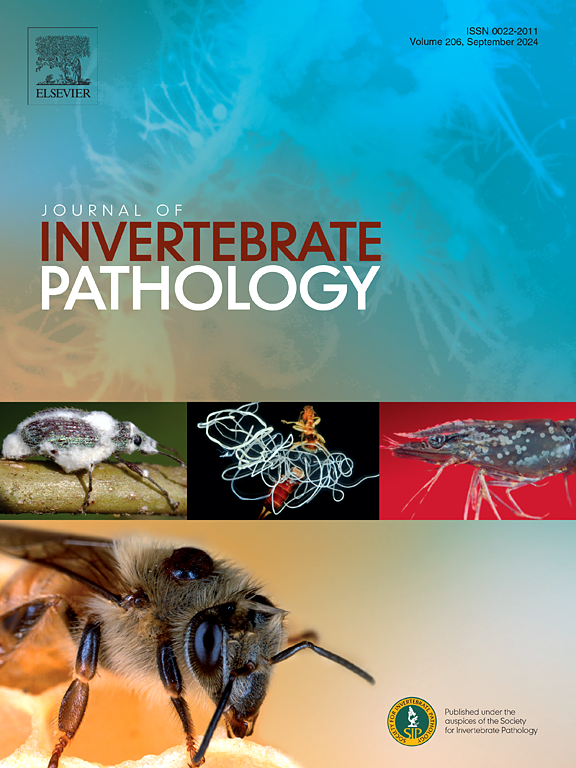球孢白僵菌erl836介导的松子甲虫脂肪体氧化磷酸化及免疫反应的抑制
IF 2.4
3区 生物学
Q1 ZOOLOGY
引用次数: 0
摘要
日本松锯甲虫(JPSB), Monochamus alternatus Hope,是导致松树枯萎的松树枯萎线虫的载体。化学药剂已被用于防治JPSB,但它们往往造成环境污染和昆虫抗性。另一种方法是利用球孢白僵菌ERL836对JPSB进行控制,并对JPSB全体进行RNA-seq分析,研究宿主的防御机制。然而,JPSB脂肪体作为宿主防御和能量代谢的关键器官,其防御机制却很少受到关注。ERL836对JPSB成虫有较高的杀虫活性,对尸体上活跃的产孢有一定的杀虫活性,有可能向其他JPSB种群传播。从感染的JPSB脂肪体的RNA-seq来看,与未处理的对照组相比,编码能量代谢氧化磷酸化的基因在2 天上调,但最终在4 天下调,这表明真菌感染期间能量代谢减少。同时,在脂肪体的免疫应答中,对宿主防御应答有不利调节作用的丝氨酸蛋白酶抑制剂(serpin)基因不断上调,从而抑制了大部分免疫应答。包括Spn42和SRPN2在内的JPSB蛇形蛋白与ERL836蛇形蛋白在系统发育上接近。在真菌发病机制中,虽然能量代谢途径下调,但JPSB防御途径被serpin基因的过度表达强烈抑制。提示脂肪体蛇形蛋白基因的活跃表达可能与真菌的快速感染有关,从而为真菌的感染创造了更有利的环境。在接下来的工作中,需要进一步明确诱导JPSB蛇形蛋白表达的因素,并进一步研究真菌蛇形蛋白的作用。本文章由计算机程序翻译,如有差异,请以英文原文为准。

Beauveria bassiana ERL836-mediated suppression of oxidative phosphorylation and immune response in fat body of Japanese pine sawyer beetle
Japanese pine sawyer beetle (JPSB), Monochamus alternatus Hope, is a vector of the pine wilt nematode that causes pine wilting. Chemicals have been used to control JPSB, but they often cause environmental pollution and insect resistance. Alternatively, Beauveria bassiana ERL836 could be used to control JPSB and RNA-seq of the full body of JPSB was conducted to investigate host defense mechanisms. However, little interest was given to the defense mechanisms of the JPSB fat body which is a key organ of host defense and energy metabolism. ERL836 showed high insecticidal activity against JPSB adults and active sporulation on the cadavers, which potentially enables active spreading to other JPSB populations. From the RNA-seq of infected JPSB fat body, genes encoding for oxidative phosphorylation for energy metabolism were up-regulated 2 days but finally down-regulated 4 days compared to non-treated control, suggesting a reduction of energy metabolism during fungal infection. Simultaneously in the immune response of the fat body, serine protease inhibitor (serpin) genes which adversely regulate host defense response were continuously up-regulated and consequently most immune response were suppressed. The JPSB serpins including Spn42 and SRPN2 were phylogenetically close to ERL836 serpins. In fungal pathogenesis, JPSB defense pathways were strongly suppressed with the over-expression of serpin genes, although energy metabolism pathways were down-regulated. This work suggests that active expression of fat body serpin genes is possibly related to the speedy fungal infection, which could create a more favorable environment for fungal infection. In the next work, factors inducing the expression of JPSB serpins need to be clarified and the roles of fungal serpins would be investigated.
求助全文
通过发布文献求助,成功后即可免费获取论文全文。
去求助
来源期刊
CiteScore
6.10
自引率
5.90%
发文量
94
审稿时长
1 months
期刊介绍:
The Journal of Invertebrate Pathology presents original research articles and notes on the induction and pathogenesis of diseases of invertebrates, including the suppression of diseases in beneficial species, and the use of diseases in controlling undesirable species. In addition, the journal publishes the results of physiological, morphological, genetic, immunological and ecological studies as related to the etiologic agents of diseases of invertebrates.
The Journal of Invertebrate Pathology is the adopted journal of the Society for Invertebrate Pathology, and is available to SIP members at a special reduced price.

 求助内容:
求助内容: 应助结果提醒方式:
应助结果提醒方式:


